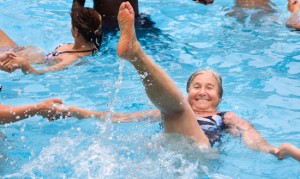 A disproportionate number of older adults suffer from depression, according to data collected by the National Institute of Mental Health. It is estimated that millions of senior citizens suffer from dementia. And older adults commit suicide at higher rates compared to other age groups. [Read more…]
A disproportionate number of older adults suffer from depression, according to data collected by the National Institute of Mental Health. It is estimated that millions of senior citizens suffer from dementia. And older adults commit suicide at higher rates compared to other age groups. [Read more…]
The link between depression and dementia
Dementia and antipsychotic medicine: A new review
 One in three senior citizens suffer from Alzheimer’s disease or dementia when they die, according to the Alzheimer’s Association. Often patients with dementia have behavioral problems such as agitation, aggression, anxiety and depression. [Read more…]
One in three senior citizens suffer from Alzheimer’s disease or dementia when they die, according to the Alzheimer’s Association. Often patients with dementia have behavioral problems such as agitation, aggression, anxiety and depression. [Read more…]
The facts on Social Security
More than 75 years ago, the U.S. government created Social Security, the federal insurance program that provides benefits to individuals and their families who can no longer work because of disability, retirement or death. The program is complex, and its details are often debated among politicians.
Earlier this year, the Economic Policy Institute and the National Academy of Social Insurance published a guide that explains the facts about the Social Security program to young people. The document includes detailed, evidence-based explanations of Social Security’s history, beneficiaries, financing, and shortfalls. It pulls data from the Office of the Chief Actuary of the Social Security Administration, Congressional Budget Office, the Employee Benefits Research Institute, and the Center for Retirement Research.
Here’s a sampling of interesting facts from the document:
- In 2012, about 159 million individuals or 94% of the American workforce, worked in Social Security-covered employment. (Those not covered include government employees covered by other insurance programs, farm workers who do not meet minimum work requirements and students.)
- Approximately 55 million Americans received Social Security benefits in 2011. Seventy percent were retirees; 19 percent were disability beneficiaries and 11 percent were survivors of deceased workers.
- Without Social Security income, it is estimated that nearly half senior citizens would be living in poverty. Instead, fewer than 10 percent of seniors live in poverty.
- Because the U.S. population is aging and people are living longer, the Social Security program is projected to run up a deficit. The projected shortfall is 2.67% of taxable earnings over the next 75 years.
- There are a variety of ways to compensate for the deficit including raising taxes, expanding coverage, investing in equities, increasing the retirement age and reducing cost-of-living increases.
The guide concludes that Social Security fulfills an important need in our society as an insurance program for American workers. To learn more about Social Security benefits and about how your payroll taxes are used, it’s worth checking out this evidence-based document.
Can we fend off chronic disease? The evidence says yes
 We have all heard that physical fitness is an important factor in health, but how important a factor? And is it ever too late to get fit?
We have all heard that physical fitness is an important factor in health, but how important a factor? And is it ever too late to get fit?
A study published earlier last month in the Archives of Internal Medicine suggests that becoming fit in middle age, even if you haven’t previously exercised, can stave off illness later in life.
In the study, researchers collected medical records for more than 18,000 healthy middle-aged men and women who’d visited the Cooper Institute in Dallas, Texas for a check-up since 1970. Each subject took a treadmill test to determine their aerobic fitness at their first check-up. Then the researchers checked their Medicare records from 1999 through 2009.
The study found that people who were least fit at the time of their initial check-up were the most likely to developed chronic conditions such as heart disease and cancer early in the aging process. Those who were most in middle-age developed the same conditions, but significantly later in life compared to the less fit.
The take-home message of this study actually parallels a lesson shared in Karl’s book 30 Lessons for Living, which shares advice from America’s elders. The lesson is: It’s not dying you should worry about – it’s chronic disease.
This study provides evidence that you can actually do something to help prevent chronic disease later in life – exercise!
The study is backed up by several systematic reviews. One published in the Journal of Science and Medicine in Sport found physical activity helps prevent heart disease, cancer and diabetes. Another published in Obesity Reviews found individual who are overweight but have good aerobic fitness are at lower risk of cardiovascular disease compared with individuals with normal weight and poor fitness.
The bottom line: Physical fitness can help you lead a healthier, happier life no matter what your age.
New evidence: Vitamin D helps prevent falls
Vitamin D is one of those supplements that makes it into the news media frequently. Here on EBL, we’ve written before about the U.S. Institute of Medicine’s recommendations on Vitamin D intake.
Now there is a new recommendation that taking Vitamin D supplements can help prevent falls in people over 65 years old with a higher risk of falling.
In a review of nine separate studies, the United States Preventative Services Task Force came to the conclusion a daily dose of 800 international units reduced the risk of falling by about 17 percent, compared with those who did not take the vitamin.
“The exact mechanism is not known, but it seems to help muscle strength and balance,” Dr. Al Siu, vice chairman of the task force and chairman of the geriatrics and palliative medicine department at Mount Sinai School of Medicine, told the New York Times.
The panel also made two other recommendations. Doctors should do a comprehensive assessment of patients’ risk of falling – including asking about falling history and observing patients stand up and walk – to identify those at higher risk. And patients’ should exercise to improve strength and balance.
Falls are the leading cause of injury in adults 65 and older. While there’s no sure-fire way to prevent them, we have evidence that some interventions do work. That’s important information for all of us to know.
The link between happiness and health
A positive mood can certainly make for a brighter day, but now there’s new evidence that is also m akes for a healthier heart.
akes for a healthier heart.
A systematic review by researchers at Harvard University looked at more than 200 studies on cardiovascular risks and emotional state – the largest ever reviewed in one paper. They found that patients who reported a positive mental state were less likely to suffer from heart disease and stroke.
Feeling such as optimism, happiness and hope seemed to protect against cardiovascular disease independently of risk factors like smoking and obesity.
While the link provides an interesting insight, it is difficult to tell whether happiness produces health, or whether healthier people are, by nature, happier. In either case, it’s prudent to cultivate a positive mindset.
At Cornell, psychologist Anthony Ong’s research focuses on how people maintain a positive attitude, even when they experience stressful events like the loss of a loved one. His work has shown that social connectedness – having a supportive relationships with those around you – contributes these daily positive emotions, and leads people to be more resilient in the face of adversity.
The take home message: Get out in your community and cultivate some good feelings!
Building and maintaining relationships is one key to healthy aging
There are some clear risk factors that lead to an earlier death such as smoking, alcohol consumption and obesity. But are t here other factors that influence health and wellness later in life – behaviors that researchers have yet to study?
here other factors that influence health and wellness later in life – behaviors that researchers have yet to study?
Until recently, one of those unknown factors was social relationships. Anecdotal evidence suggested that people with strong social relationships reduced their risk of mortality, but there was little evidence to back up the suggestion. While many medical studies included a measure of social isolation, no one had looked at the issue on a broader scale.
That is, until researchers at Brigham Young University conducted a systematic review of the literature on how social relationships impact the risk of dying later in life. They reviewed 148 studies that included more than 300,000 participants that included information about how people died, their initial health status and pre-existing health conditions, as well as type of assessment of social relationships.
Over all the data they reviewed, they found a 50 percent increased likelihood of survival for participants with stronger social relationships. The lack of social relationships had more influence on mortality rates that other risk factors like physical activity and obesity.
The researchers noted that more complex measurements of social relationships – instead of simple indications such as marital status – were more predictive of death.
The take-home message is that your relationships later in life are just as important as what you eat and drink, how much exercise you get, and other important health behaviors. More research is needed to determine how relationships improve well-being, and specific characteristics that contribute to the trend. In the meantime, it’s important for medical professionals to consider social relationships in their treatment plans for older adults.
Are antipsychotic medications helpful for nursing home patients?
 A systematic review published in the Journal of the American Geriatrics Society looked at medical records nearly 84,000 nursing home patients in 45 states to determine if taking antipsychotic medications increased the risk of other medical problems, specifically heart attack, stroke, serious bacterial infections and hip fracture.
A systematic review published in the Journal of the American Geriatrics Society looked at medical records nearly 84,000 nursing home patients in 45 states to determine if taking antipsychotic medications increased the risk of other medical problems, specifically heart attack, stroke, serious bacterial infections and hip fracture.
The review found that within 180 days of starting antipsychotic medicines, nursing home patients were at higher risk for bacterial infections, heart attack and hip fracture, but not at higher risk for stroke. The study also identified which specific medications lead to increased problems, and which doses proved to be safer for residents.
On the whole, this is exactly the kind of information that medical providers need to make the best decisions for patients with complex medical issues. The scope of this study – encompassing thousands of patients across the nation – and detail of data about specific medicines and doses provides a roadmap to help residents stay healthy.
Can you boost your IQ? The evidence says yes
It’s an age-old question studied by researchers for more than a century: Is there anyone to make your-self smarter?
In the early days of this inquiry, researchers were certain the answer was no. But studies over the past two decade have proven otherwise. Yes, you can raise your intelligence quotient,  or IQ. In fact, the very question was covered in a recent Wall Street Journal article.
or IQ. In fact, the very question was covered in a recent Wall Street Journal article.
While I didn’t manage to track down a systematic review of the topic, I did find a body of literature pointing to methods for improving your IQ. One study that followed 250 adults over the course of six years found that people in jobs involving complex relationships, elaborate systems or difficult problems tend to perform better over time on cognitive tests.
Likewise, the work of Cornell Professor Steve Ceci has found that schooling raises IQ by several points a year, mainly because students are exposed to information and problem-solving often included in cognitive tests.
In another recent study, British students were given IQ tests and brain scans at ages 12 to 16 and again four years later. The students with significant improvements in IQ – 15 points or more – showed changes in gray matter in areas corresponding with their improvements.
Alas, the issue is complicated. Another recent study tested adults using at Wii video game, reading and reference ability. While the participants showed improvements in what they practiced, their new-found skills didn’t transfer well to other areas, suggesting that learning for adults may be more narrow than for young adults and children.
Clearly, more research is needed. But it seems that we can say definitely that if you practice something – whether physical or mental – you will see improvements in that specific area.
Video feature: Q&A on decision-making
 Most of us have seen it before. Maybe it was a neighborhood boy riding his bike down the middle of the road, or a group of girls performing stunts on the diving board at the local pool. Whatever the circumstance, it’s fairly common knowledge that young people don’t always make the best decisions. In fact, it’s a topic we’ve written about here on EBL. But given the stakes, it’s one worth revisiting.
Most of us have seen it before. Maybe it was a neighborhood boy riding his bike down the middle of the road, or a group of girls performing stunts on the diving board at the local pool. Whatever the circumstance, it’s fairly common knowledge that young people don’t always make the best decisions. In fact, it’s a topic we’ve written about here on EBL. But given the stakes, it’s one worth revisiting.
Earlier this month, Cornell professor Valerie Reyna — an expert in decision-making — was featured in a new video on the topic. In it, Reyna explains the science behind decision-making in adolescents, as well as how the neuroscience of decision-making plays a role in other areas of our lives including health care and memory.
It’s certainly worth a watch!



